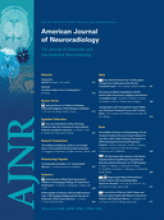Research ArticleBrain
Open Access
Using High-Resolution MR Imaging at 7T to Evaluate the Anatomy of the Midbrain Dopaminergic System
M. Eapen, D.H. Zald, J.C. Gatenby, Z. Ding and J.C. Gore
American Journal of Neuroradiology April 2011, 32 (4) 688-694; DOI: https://doi.org/10.3174/ajnr.A2355
M. Eapen
D.H. Zald
J.C. Gatenby
Z. Ding

References
- 1.↵
- Oades R,
- Halliday GM
- 2.↵
- Williams S,
- Goldman-Rakic P
- 3.↵
- Francois C,
- Yelnik J,
- Percheron G
- 4.↵
- Grace AA,
- Bunney BS
- 5.↵
- Schultz W,
- Romo R
- 6.↵
- Salamone JD
- 7.↵
- Ikemoto S,
- Panksepp J
- 8.↵
- Redgrave P,
- Prescott TJ,
- Gurney K
- 9.↵
- Kakade S,
- Dayan P
- 10.↵
- Schultz W
- 11.↵
- Fearnley JM,
- Lees AJ
- 12.↵
- Tomasi D,
- Goldstein RZ,
- Telang F,
- et al
- 13.↵
- Takahashi H,
- Koeda M,
- Oda K,
- et al
- 14.↵
- Murray GK,
- Corlett PR,
- Clark L,
- et al
- 15.↵
- Duguid J,
- Paz RDL,
- DeGroot J
- 16.↵
- 17.↵
- Shibata E,
- Sasaki M,
- Tohyama K,
- et al
- 18.↵
- Manova ES,
- Habib CA,
- Boikov AS,
- et al
- 19.↵
- Thomas BP,
- Welch EB,
- Niederhauser BD,
- et al
- 20.↵
- Zecca L,
- Berg D,
- Arzberger T,
- et al
- 21.↵
- Sofic E,
- Riederer P,
- Heinsen H,
- et al
- 22.↵
- Connor JR,
- Menzies SL
- 23.↵
- Zecca L,
- Gallorini M,
- Schuenemann V,
- et al
- 24.↵
- Sasaki M,
- Shibata E,
- Tohyama K,
- et al
- 25.↵
- 26.↵
- Feinberg DA,
- Oshio K
- 27.↵
- Bernstein MA,
- King KF,
- Zhou XJ
- 28.↵
- Li C,
- Kao C-Y,
- Gore JC,
- et al
- 29.↵
- Naidich TP,
- Duvernoy HM,
- Delman BN,
- et al
- 30.↵
- Paxinos G,
- Huang X
- 31.↵
- Duvernoy HM
- 32.↵
- Drayer B,
- Burger P,
- Darwin R,
- et al
- 33.↵
- Braak H,
- Braak E
- 34.↵
- Yelnik J,
- François C,
- Percheron G,
- et al
- 35.↵
- Zecca L,
- Pietra R,
- Goj C,
- et al
- 36.↵
- Double K,
- Gerlach M,
- Schünemann V,
- et al
- 37.↵
- Rutledge JN,
- Hilal SK,
- Silver AJ,
- et al
- 38.↵
- 39.↵
- Drayer B,
- Olanow W,
- Burger P,
- et al
- 40.↵
- Braffman BH,
- Grossman RI,
- Goldberg HI,
- et al
- 41.↵
- Martin W,
- Wieler M,
- Gee M
- 42.↵
- Dexter DT,
- Carayon A,
- Javoy-Agid F,
- et al
- 43.↵
- Drayer BP
- 44.↵
- Stern M,
- Braffman B,
- Skolnick B,
- et al
- 45.↵
- Ordidge R,
- Gorell J,
- Deniau J,
- et al
- 46.↵
- Gorell J,
- Ordidge R,
- Brown G,
- et al
- 47.↵
- Bunzeck N,
- Duzel E
- 48.↵
- D'Ardenne K,
- McClure SM,
- Nystrom LE,
- et al
In this issue
Advertisement
M. Eapen, D.H. Zald, J.C. Gatenby, Z. Ding, J.C. Gore
Using High-Resolution MR Imaging at 7T to Evaluate the Anatomy of the Midbrain Dopaminergic System
American Journal of Neuroradiology Apr 2011, 32 (4) 688-694; DOI: 10.3174/ajnr.A2355
0 Responses
Jump to section
Related Articles
Cited By...
- Sensing and seeing associated with overlapping occipitoparietal activation in simultaneous EEG-fMRI
- Direct In Vivo MRI Discrimination of Brain Stem Nuclei and Pathways
- The role of dopaminergic nuclei in predicting and experiencing gains and losses: A 7T human fMRI study
- Reproducibility of the correlative triad among aging, dopamine receptor availability, and cognition
- 3T MRI Whole-Brain Microscopy Discrimination of Subcortical Anatomy, Part 1: Brain Stem
- Perceptual Competition Promotes Suppression of Reward Salience in Behavioral Selection and Neural Representation
- New Clinically Feasible 3T MRI Protocol to Discriminate Internal Brain Stem Anatomy
- Brain regulation of appetite in twins
- Distinct Contributions of Ventromedial and Dorsolateral Subregions of the Human Substantia Nigra to Appetitive and Aversive Learning
- Ultra-High-Field MR Neuroimaging
- Usefulness of Quantitative Susceptibility Mapping for the Diagnosis of Parkinson Disease
- Influence of Motivation on Control Hierarchy in the Human Frontal Cortex
- Distinct Midbrain and Habenula Pathways Are Involved in Processing Aversive Events in Humans
- Low-Power Inversion Recovery MRI Preserves Brain Tissue Contrast for Patients with Parkinson Disease with Deep Brain Stimulators
- Visualization of nigrosome 1 and its loss in PD: Pathoanatomical correlation and in vivo 7 T MRI
This article has not yet been cited by articles in journals that are participating in Crossref Cited-by Linking.
More in this TOC Section
Similar Articles
Advertisement











